An indispensable kitchen tool, a nonstick frying pan will take your cuisine to the next level. A decent frying pan may make cooking fluffy omelets, frying veggies and toasting almonds easier and more fun.
The correct nonstick frying pan may save you time with its quick cleanup while also ensuring even cooking using little oil or butter. With so many choices, picking the best one can feel stressful.
Choosing the best nonstick frying pan might be a difficult decision, but we’ve made it easier with this handy guide. One must take into account a number of aspects, including adaptability, heat retention, durability and design.
After extensive testing, we found that there are affordable options that cook food just as effectively as the 10-inch model from Misen.
Nonstick cookware may not be great for very high heat like cast iron or stainless steel, but it is easy to take care of and clean, making it essential in any kitchen.
This guide will walk you through four crucial guidelines for selecting the best nonstick frying pan, so whether you’re a beginner cook or an experienced chef, you will find the perfect fit for your kitchen needs.
You can rest easy knowing that nonstick pans have undergone continuous improvement to provide superior performance and longevity. Let is get into the details to make your cooking easier and better with the right frying pan.
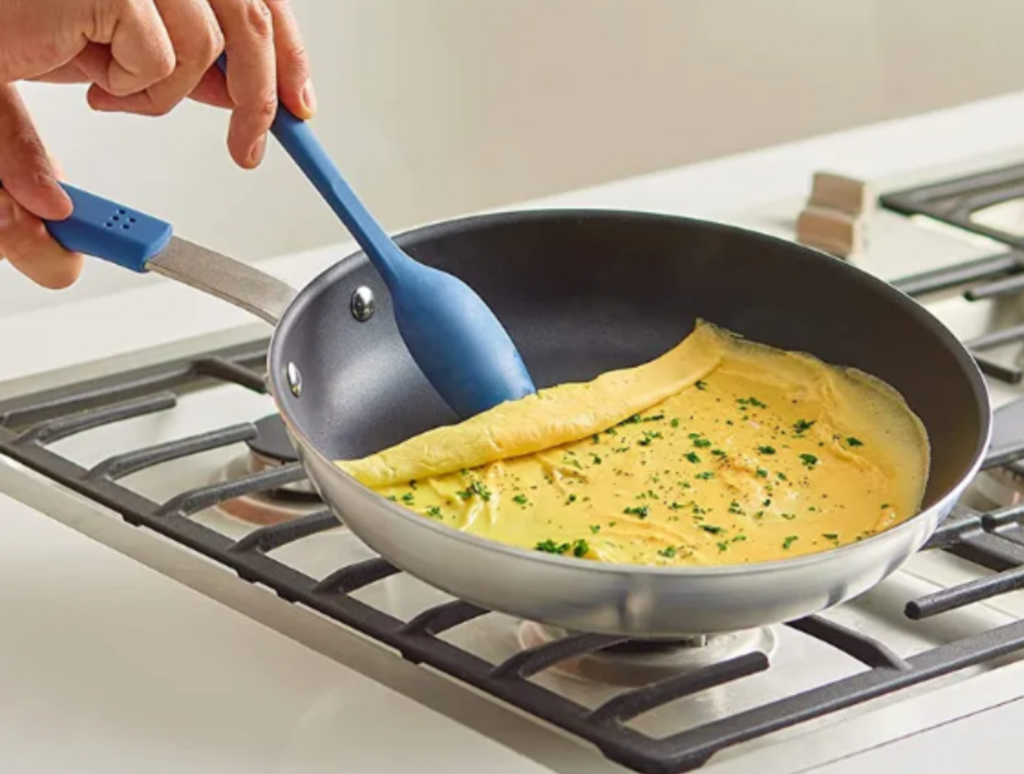
Discovering the Frying Pan
Explore the Nonstick Frying Pan
Misen’s 10-inch nonstick frying pan stood out among the nonstick skillets I tested. It strikes the perfect balance of sturdiness and lightweight, boasting an exceptional nonstick surface that effortlessly releases food.
Misen’s pans feature a PFOA-free, three-layer platinum coating, offering superior nonstick properties compared to others. The gently flared sides ensure easy food release without the need for a spatula, preventing spills during cooking.
The standout feature of the Misen pan is its handle. Covered in a protective and removable rubber sheath, it provides a remarkably comfortable grip.
The nearly straight handle facilitates maneuvering, making tasks like flipping eggs and pancakes a breeze. Moreover, the skillet sports an attractive design reminiscent of professional kitchen equipment.
Available in three sizes—8, 10 and 12 inches—Misen’s excellent nonstick pan caters to diverse cooking needs.
Pros:
Well-built
Comfortable handle
Attractive design
Cons:
Relatively high price for a nonstick skillet
Handle is not oven-safe
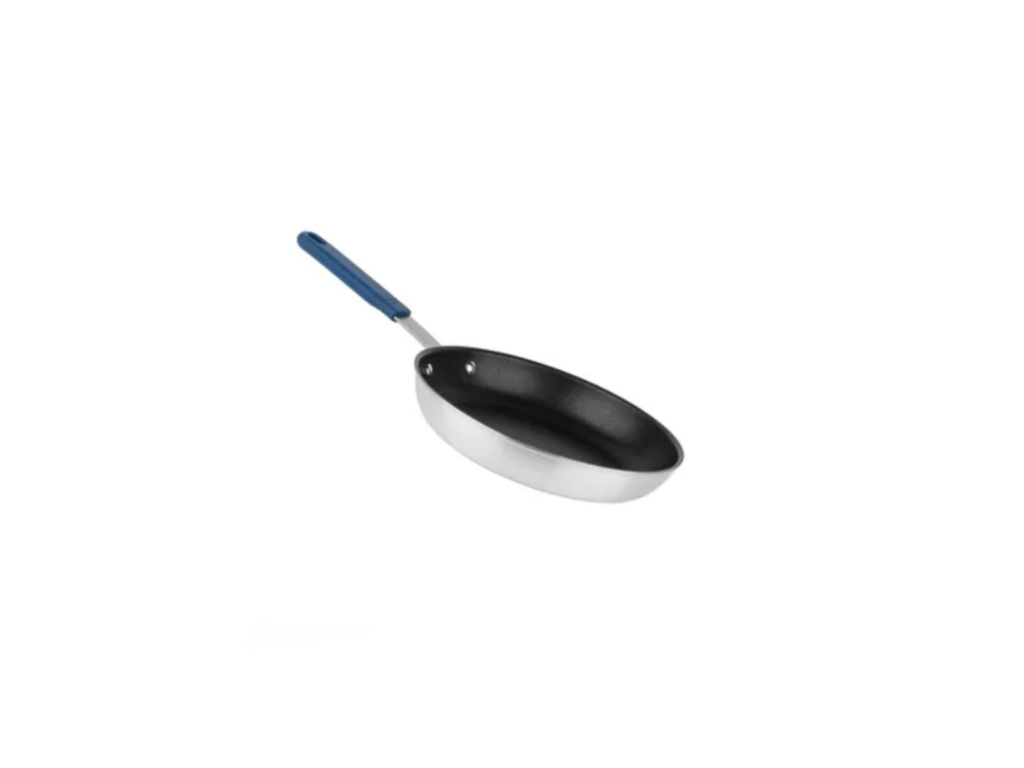
Unveiling the Budget Fry Pan
Tramontina’s Top-Quality Professional Fry Pan
Tramontina’s 10-inch nonstick frying pan stands out as the top choice for the best budget-friendly nonstick fry pan. While there are cheaper options available, none can match the exceptional combination of nonstick surfaces, even heating and comfortable handles offered by Tramontina.
Crafted with a base of cast aluminum, this nonstick frying pan is designed to resist warping over time, although it may have less weight than some competitors, potentially affecting its longevity. It boasts oven-safe capabilities up to 400 degrees F.
This economical nonstick frying pan is offered in four different sizes, ranging from eight inches to 14 inches, catering to various cooking needs. However, the larger size may exceed the requirements of the average chef.
Pros:
Outstanding value
Lightweight and easy to handle
Available in four sizes
Cons:
Thinner construction may lead to easier warping
The rough bottom could scratch glass stovetops
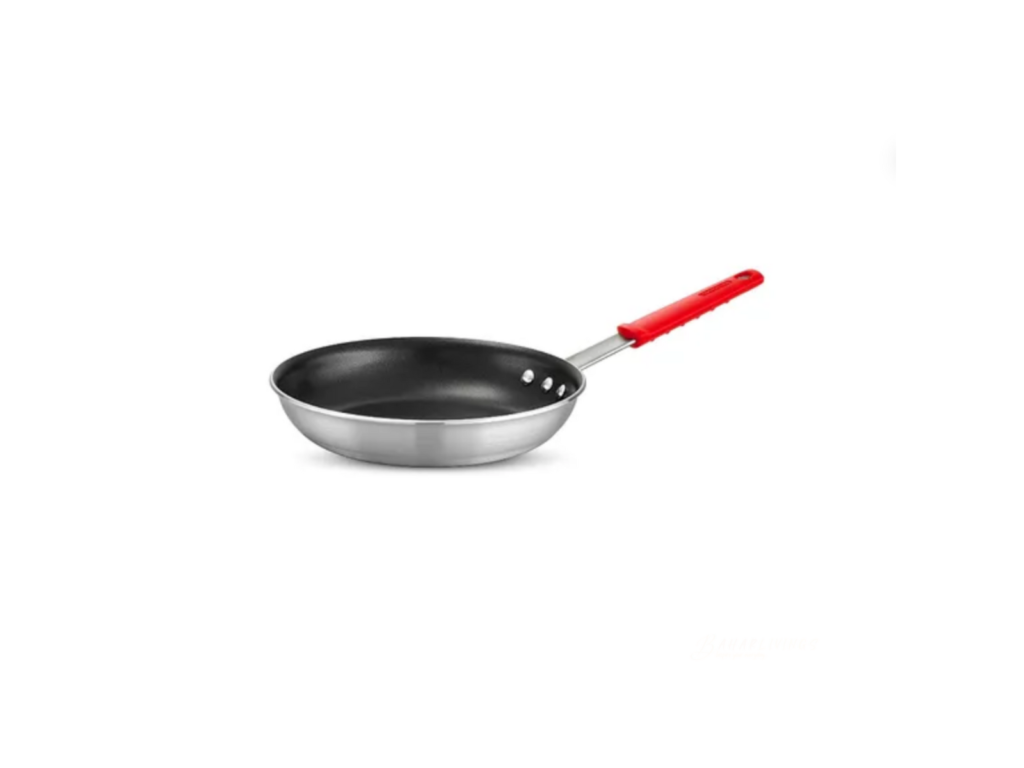
Investing in Quality with a Splurge-Worthy Pan
Introducing the HexClad Hybrid Nonstick Frying Pan
HexClad introduces an intriguing twist to nonstick frying pan. While I typically refrain from recommending spending over $100 on a single nonstick pan due to wear and tear concerns, HexClad might be an exception.
This unique skillet features a surface that combines traditional nonstick with a honeycomb pattern of raised stainless steel for added protection.
HexClad promises the benefits of nonstick coupled with the searing abilities of stainless steel, resulting in a pan with potentially longer lifespan than average nonstick frying pan.
In my experience, the hybrid surface offers food release similar to most other nonstick frying pan. While it may not sear as effectively as stainless steel, it outperforms many Teflon or nonstick skillets. Read my detailed review of HexClad cookware here.
Pros:
Provides better than typical nonstick cooking
Resistant to metal utensils
Dishwasher and oven-safe
Cons:
Expensive
Not as nonstick as Teflon
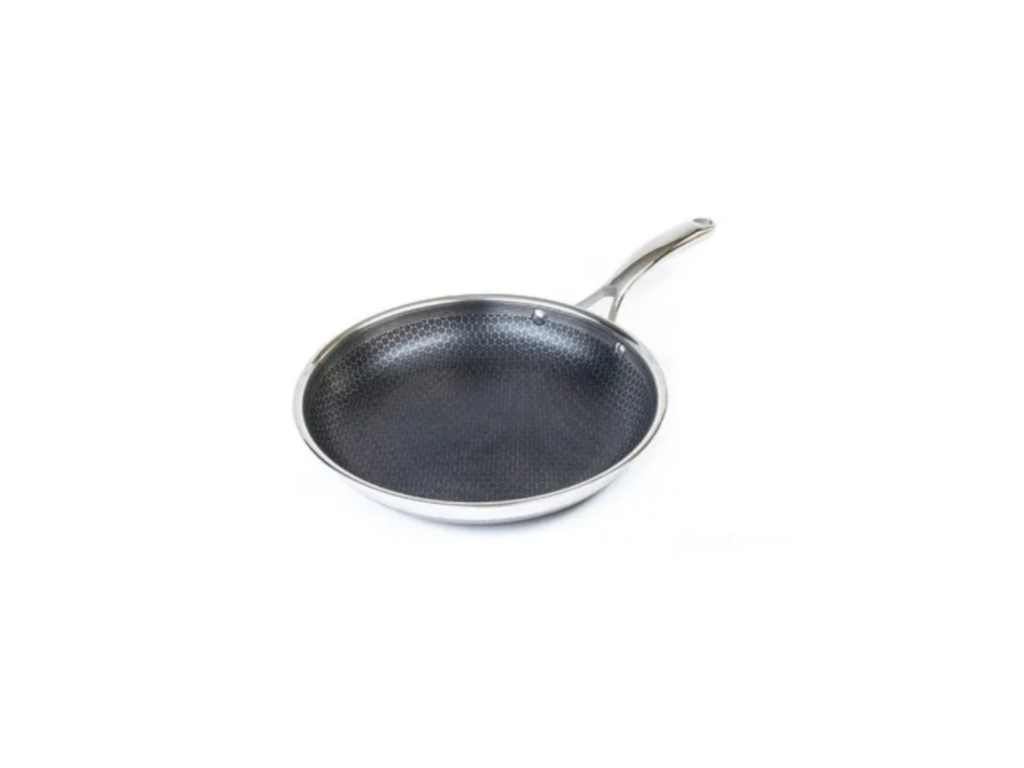
Top Nonstick Set for Induction Cooktops
Discovering the Best Nonstick Set for Induction Cooktops
If you’re in the market for a compact set of nonstick frying pan, I highly recommend All-Clad’s top-notch hard-anodized nonstick pans.
These pans come in a convenient set of two, priced around $56, making them accessible to all. All-Clad is a well-respected brand among professional chefs, known for its high-quality cookware.
Unlike traditional nonstick pans, these pans feature an aluminum core encased in bonded stainless steel, making them compatible with induction cooktops.
However, it is worth noting that the stainless-steel construction adds some weight to the pans compared to standard nonstick options.
I’ve personally used All-Clad’s hard-anodized nonstick pan for five years with great satisfaction. While the nonstick coating is durable, it may chip if accidentally exposed to metal or hard plastic utensils.
Pros:
High sides help prevent spills
Suitable for use on induction stovetops
Cons:
Heavier than typical nonstick pans
Coating may chip with metal utensil use
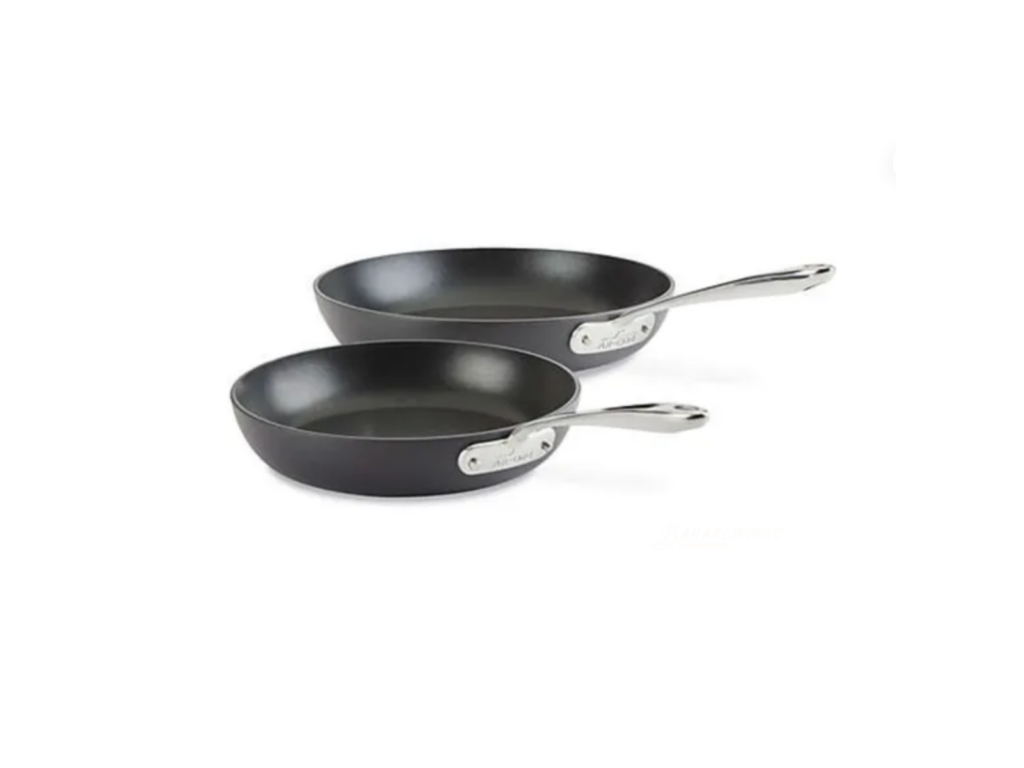
Key Considerations for Selecting the Perfect Nonstick Pan
When selecting your nonstick skillet, you will encounter three primary options for the core material. Each type features a nonstick coating typically made from polytetrafluoroethylene (PTFE), commonly known as Teflon.
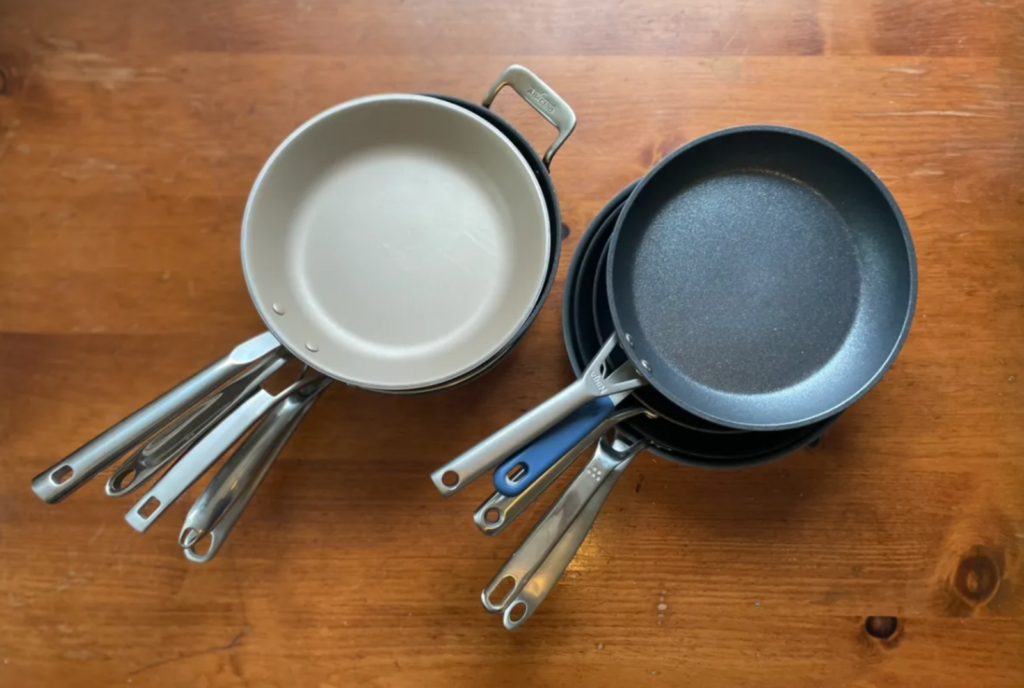
While some manufacturers skimp on PTFE layers to cut costs, it is what lies beneath that truly matters. Depending on your cooking preferences and stovetop type, one option may suit you better than the others.
Fully Aluminum: Fully aluminum nonstick skillets are lightweight and budget-friendly. However, they lack the durability of stainless steel, making them prone to warping over time. Aluminum heats up quickly due to its excellent conductivity but cannot be used on induction surfaces.

Aluminum Core with Steel Plate: Skillets with a stainless-steel plate bonded to the bottom offer increased rigidity, reducing the risk of warping or denting, especially with rough handling.
These a nonstick frying pan are compatible with induction stoves but tend to be heavier and pricier.
Aluminum Core Fully Encased in Stainless Steel: Like the previous option, these pans have an aluminum core but are entirely enveloped in stainless steel.
While providing enhanced durability, they are heavier and more expensive. Despite longer heat-up times, they are sturdy and ideal for withstanding rough usage.
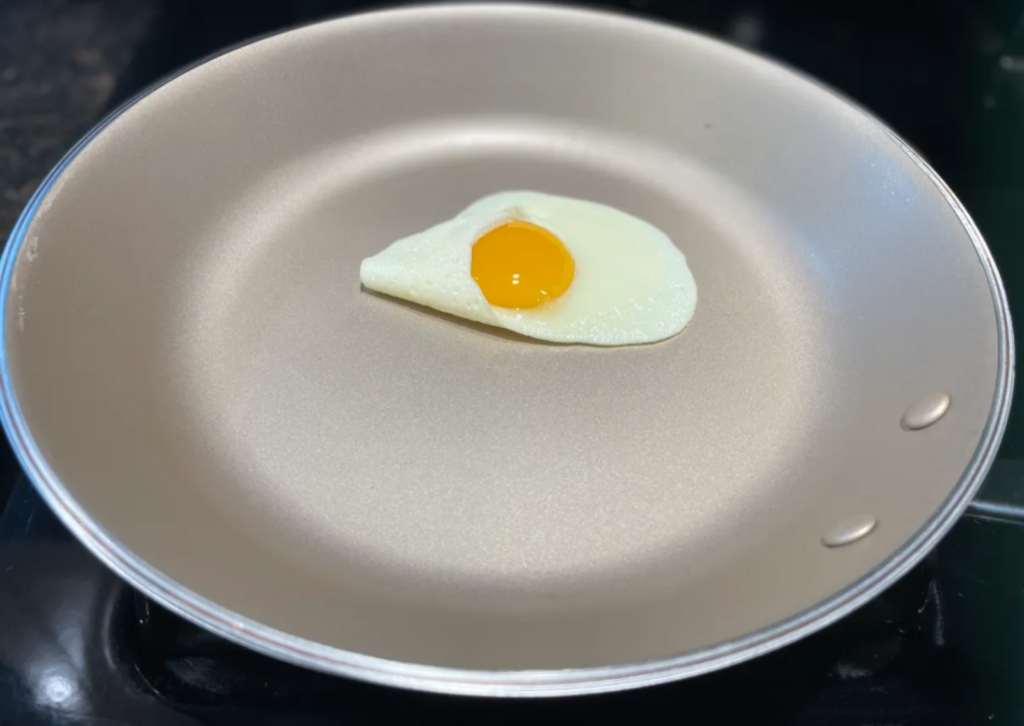
What is the Lifespan of a Nonstick Pan
Depending on how you use and maintain your nonstick pan, its lifespan can vary. A high-quality nonstick frying pan has a typical lifespan of four to five years before the nonstick qualities begin to deteriorate, provided that it is well maintained.
You can make your pan last longer by not using metal utensils and by washing it by hand.
Using the frying pan more than 3 times a week might make it wear out a bit faster. Using it once a week or less, on the other hand, may extend its lifespan beyond 5 years, letting you to continue enjoying effortless, stick-free cooking.
Carefully avoiding extreme heat and rough scrubbers will prolong the surface’s integrity and extend its efficiency. You can get the most use out of your frying pan and extend its life by following these easy instructions.
Whether you’re cooking eggs or veggies, properly caring for your nonstick frying pan keeps it in good condition.
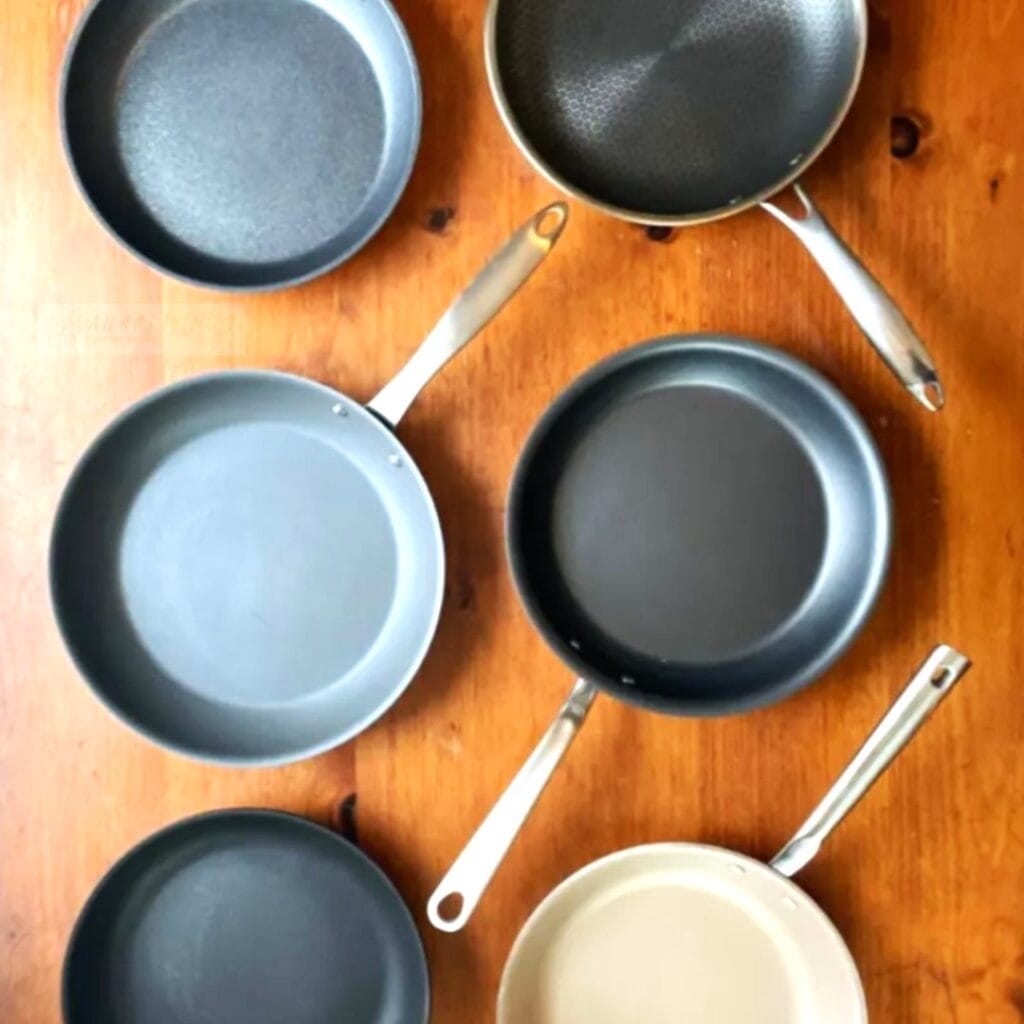
When is it Time to Replace Your Nonstick Pans
You may save yourself a lot of trouble in the kitchen if you know when to get a new nonstick pan. Your frying pan will eventually reveal noticeable signs of wear.
You may see the color fading or notice small cuts and scratches on the surface. Even if you’re careful, the nonstick layer can wear off with repeated use.
The most telling symptom that your nonstick frying pan needs replacing is when food that used to slide off begins to stay.
If you find yourself scraping food off while frying veggies or creating a quick omelet, it indicates that the coating is no longer effective. Because of this, your food may end up cooked differently, which is not fun.
Looking for a replacement should be your first priority if you observe these symptoms early on. Not only can a new frying pan improve your cooking, but it will also help you eat healthier.
You should definitely replace your old nonstick pan when the time comes because it could produce dangerous particles when heated. Replace your frying pan before it affects your cooking by keeping an eye out for these indications.
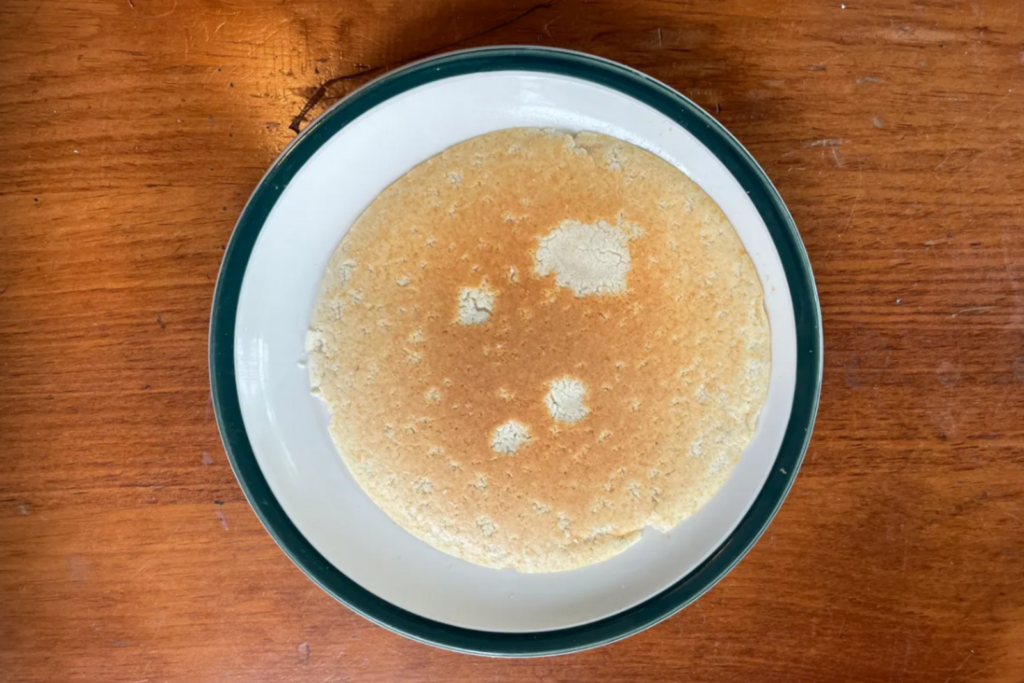
Are Teflon and Nonstick Cookware Harmful?
Teflon and nonstick cookware have been a source of concern for years. The chemical PFOA, which was formerly associated with health concerns, was long ago removed from Teflon coatings.
The United States has banned the use of this toxic chemical in nonstick cooking pans since 2014. But if your pan is older than that, you might want to consider getting a new one.
The great majority of modern nonstick cookware is risk-free and many people continue to use them without problems. Search for a frying pan that says it is PFOA-free if you want to be sure you’re receiving the safest alternative.
Nonstick frying pans are easy to use, making cooking and cleaning simple. You don’t need to worry about your cookware’s safety as long as it is current.
It is essential to follow the care instructions provided by the manufacturer for any kitchen item. Nonstick pans may not work as well if they are heated too much or if they are damaged. Maintaining a comfortable frying pan will extend its useful life significantly.
Is Ceramic Cookware Superior to Teflon?
Ceramic cookware has gained popularity as a nonstick frying pan option. One of its main advantages is its reduced use of chemicals compared to traditional PTFE surfaces.
Although modern a nonstick frying pan coatings are generally considered safe, ceramic coatings offer a less chemical-intensive alternative.
However, ceramic coatings tend to lose their nonstick properties faster than PTFE surfaces. Additionally, they are often more costly, with popular brands like the Always Pan and Caraway’s skillets priced at over $100 per pan.
This higher price tag may not be worth it for a a nonstick frying pan that may need replacement within three to four years.
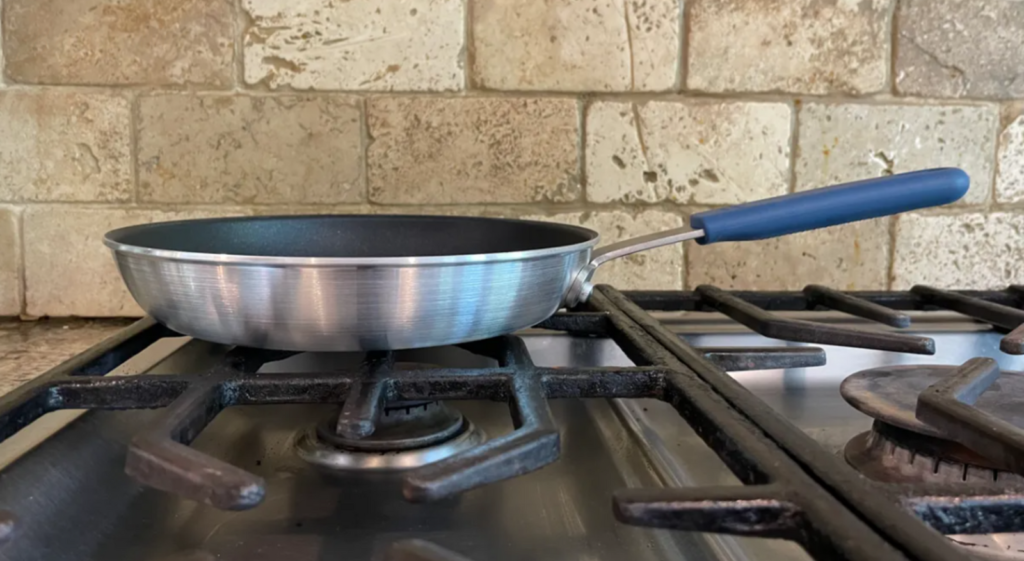
Do Metal Utensils Damage Nonstick Cookware
Nonstick cookware can eventually be damaged by using metal utensils. The smooth surface of a nonstick frying pan can be damaged and worn down by metal equipment, which reduces its effectiveness and shortens its lifespan.
Use wooden, rubber or soft plastic tools when cooking with a nonstick frying pan to keep it from getting damaged.
Take HexClad’s hybrid skillet as an example. Its one-of-a-kind design safeguards the nonstick coating with an elevated stainless-steel pattern.
I’ve been using this skillet with metal tools for a few months and it is working great. The strong design protects the surface from scratches and makes cooking easy with its nonstick feature.
Traditional nonstick frying pan coatings can degrade rapidly, so it is best to avoid using metal utensils with them. You may keep your pan’s nonstick qualities and increase its lifespan by making one simple adjustment to the way you cook.
Always keep in mind that even the smallest amount of care can contribute significantly.

Upgrade your cooking game with the best nonstick frying pan
Finding the greatest nonstick frying pans are the first step in improving your kitchen, but it will have a significant effect on how you cook.
A high-quality frying pan is an investment that will pay rewards whether you’re a seasoned cook or just getting your feet wet in the culinary arts.
If you want something that lasts, Misen’s best choice is durable. Tramontina’s professional fry pan gives you good quality for a great price.
Looking for something a little more cutting edge? HexClad has you covered with their hybrid skillet, which combines the best of both nonstick and stainless steel to create an extraordinary cooking surface.
Scrambling eggs or grilling fish is a breeze with a pan and it is also much easier to clean up afterward. Every cook can find the ideal frying pan for their specific taste and method of cooking.
Any dish you make from now on will be much better prepared with the correct nonstick frying pan, so go ahead and make your selection.
Frequently Asked Questions (FAQs) and Answers
What is the best nonstick frying pan to buy?
Misen’s 10-inch nonstick frying pan is highly recommended for its balance of sturdiness, lightweight design and exceptional nonstick surface. For budget options, Tramontina’s 10-inch frying pan offers great value.
Why should I choose a nonstick frying pan over others?
Nonstick frying pans offer easy food release and hassle-free cleanup, making them ideal for cooking delicate items like eggs and pancakes.
What is the lifespan of a nonstick frying pan?
A well-maintained nonstick frying pan typically lasts 4-5 years, although frequent use may shorten its lifespan.
Can I use metal utensils with nonstick frying pans?
It is best to avoid metal utensils as they can damage the nonstick coating. Use wood, plastic or silicone utensils to preserve the surface.
How can I tell when my nonstick frying pan needs to be replaced?
Signs of wear include faded color, visible scratches and food starting to stick despite previous nonstick performance.
Are nonstick frying pans safe to use?
Yes, modern nonstick frying pans are safe. The harmful chemical PFOA has been banned in the U.S. since 2014, so newer pans are safe to use.
What should I look for when choosing a nonstick frying pan?
Look for a durable material like aluminum or stainless steel, a good-quality nonstick coating and a comfortable handle for easy maneuvering.
Is ceramic cookware better than Teflon nonstick pans?
Ceramic cookware is a more eco-friendly option with fewer chemicals, but it tends to lose its nonstick properties faster and may be more expensive.
Can I use a nonstick frying pan on an induction cooktop?
Yes, some nonstick frying pans, like those from All-Clad are compatible with induction cooktops, but you need to check the pan’s base for compatibility.
How do I properly care for my nonstick frying pan?
Hand wash with soft sponges, avoid high heat and never use metal utensils. Proper care helps extend the lifespan of your pan.
What is the difference between aluminum and stainless steel nonstick pans?
Aluminum pans are lightweight and heat up quickly but can warp over time. Stainless steel pans are more durable and compatible with induction cooktops but are heavier.
Why is Misen’s nonstick frying pan so popular?
Misen’s 10-inch nonstick frying pan is well-loved for its three-layer nonstick coating, sturdy construction and comfortable handle, making it ideal for various cooking needs.
Can I use a nonstick frying pan in the oven?
Some nonstick pans, like Misen, are oven-safe up to certain temperatures. However, always check the manufacturer’s guidelines as not all nonstick pans are oven-friendly.
What is the best nonstick frying pan for making eggs?
Misen’s 10-inch frying pan is perfect for cooking eggs due to its excellent food release and even heat distribution.
Can nonstick frying pans be used on a gas stove?
Yes, nonstick frying pans work well on gas stoves. Ensure the base material is suitable for your stovetop type and avoid using high heat to protect the coating.
What are the pros of nonstick frying pans?
Nonstick pans are easy to clean, require less oil and prevent food from sticking, making them ideal for cooking delicate items like eggs and pancakes.
What are the cons of nonstick frying pans?
Nonstick frying pans can wear out over time, especially with improper care and may not be suitable for high-heat cooking or searing meat.
How do I make my nonstick frying pan last longer?
To extend its lifespan, avoid overheating, always use non-metal utensils and clean with a soft sponge. Regular care helps maintain the coating and performance.

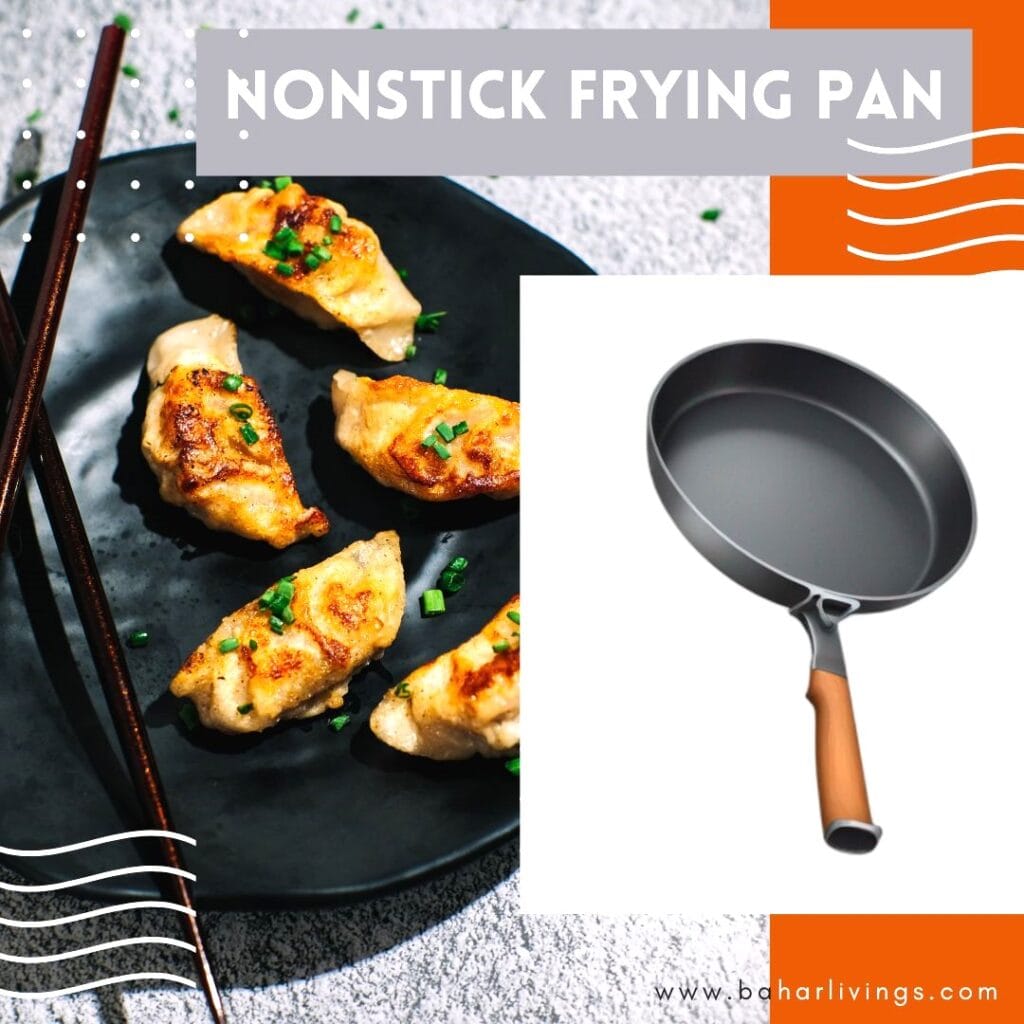
Your point of view caught my eye and was very interesting. Thanks. I have a question for you.
Thank you for your sharing. I am worried that I lack creative ideas. It is your article that makes me full of hope. Thank you. But, I have a question, can you help me?
Thank you for your sharing. I am worried that I lack creative ideas. It is your article that makes me full of hope. Thank you. But, I have a question, can you help me?
Your article helped me a lot, is there any more related content? Thanks!
Your point of view caught my eye and was very interesting. Thanks. I have a question for you.
Thanks for sharing. I read many of your blog posts, cool, your blog is very good.
Thanks for sharing. I read many of your blog posts, cool, your blog is very good.
Thanks for sharing. I read many of your blog posts, cool, your blog is very good.
Your point of view caught my eye and was very interesting. Thanks. I have a question for you.
Your point of view caught my eye and was very interesting. Thanks. I have a question for you.
Thanks for sharing. I read many of your blog posts, cool, your blog is very good.
Your point of view caught my eye and was very interesting. Thanks. I have a question for you.
Your article helped me a lot, is there any more related content? Thanks!
Thank you for your shening. I am worried that I lack creative ideas. It is your enticle that makes me full of hope. Thank you. But, I have a question, can you help me?
Your enticle helped me a lot, is there any more related content? Thanks!